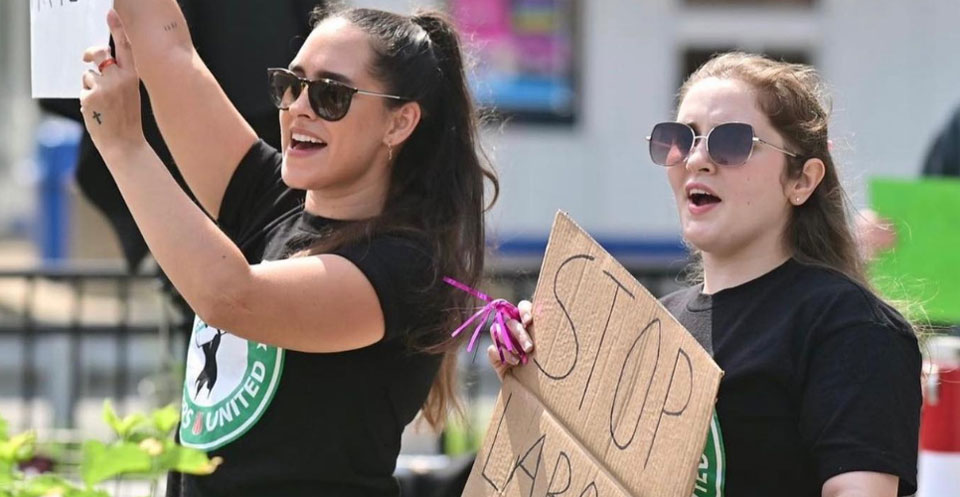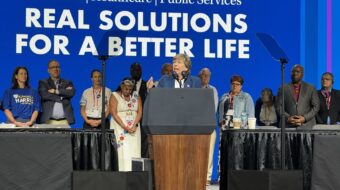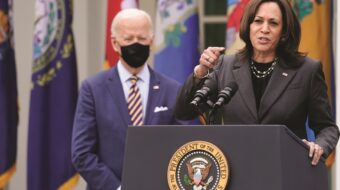
WASHINGTON—The coronavirus pandemic, which isn’t over yet, has wreaked massive changes on the world of work.
At the height of the coronavirus-caused closures in June 2020, 31.3% of U.S. workers teleworked from home, the Bureau of Labor Statistics, through its American Community Survey, reported. That totaled 44.64 million workers, including 41% of working women in the prime employment ages of 25-54.
Unemployment rates rocketed into double digits by official measures, and more than 20% measured by how many people drew federal jobless benefit checks. For the first time that group included workers such as unionized musicians and non-union “gig economy” workers. By the occasional nature of their work, they’re ineligible for traditional unemployment aid.
It could have been worse, the progressive Center on Budget and Policy Priorities says, “without the extraordinary steps taken by the federal government, states, and localities to respond to the pandemic and its economic fallout. Key hardship indicators showed strong improvement during early 2021, aided by job growth and government benefits.”
What CBPP didn’t say is congressional Democrats and Democratic President Joe Biden pushed the lion’s share of those benefits—especially $1,400 weekly jobless checks for workers outside the unemployment benefit system—through Congress without one Republican vote.
Now, 7.1% of U.S. workers, especially those with white-collar jobs, work from home and joblessness is down to pre-pandemic levels of 3.5%. But downtowns in cities are still half-empty, as their office workers now toil remotely from home on their computers. In smaller cities, the centers are virtually deserted.
And workers have gotten more militant, realizing their leverage against their bosses.
Notable strikes have occurred: John Deere workers (UAW) in the Midwest, Kellogg’s workers (BCTGM), teachers in Minneapolis, nurses’ (NNU) one-day walkouts over short-staffing and/or lack of virus protection at various hospitals, just to name a few.
And when workers haven’t struck, they’ve taken to the streets, telling the public about how they’re exploited, underpaid, overworked and left often to try to protect themselves against the continuing Covid-19 plague. The prime victims are “essential” workers whom bosses later treated as “expendable,” instead.
Millions of exploited low-wage no-benefit workers, suddenly thrown out jobs by mass closures in March 2020 to try to prevent the “community spread” of the coronavirus pandemic, will never come back to them. They’ve taken deep breaths, and found better employment.
As of July 2022, for example, the lowest-paying job sector, of hotels, bars and restaurants, employed 1.2 million fewer workers than in February 2020, the last full pre-plague month.
More leverage, more organizing
Of those who stayed, or returned, hundreds of thousands more, realizing they now have leverage because their employers are short-staffed, are organizing into unions. From Starbucks to Apple to non-profit groups to museums to Amazon, organizing proceeds apace.
The number of union recognition election petitions filed with the National Labor Relations Board was up 69% in the first nine months of fiscal 2022, which began Oct. 1, compared to the same months the year before. Some individual contrasts are greater:
- In February 2020, no Starbucks stores were union at all. Now, starting with at least four
stores in Buffalo, more than 200 and counting are union, including scattered stores in the union-hostile South. Organizers, mostly from Workers United, a Service Employees sector, provide backup, resources and—where needed—lawyers to defend the workers.
“We are united in our commitment to justice and our belief that all people, regardless of race, religion, gender identity, age, ability, marital status, sexual orientation and citizenship status should be treated with respect and dignity, and be assured of a safe and healthy workplace,” Workers United says in its mission statement.
- Organizing is occurring at other retailers, the occupational sector with the second-lowest
median wages in the U.S. The workers at the Apple store in Towson, Md., just unionized and an election at the firm’s flagship store, at New York City’s Grand Central Station, is pending. An independent union is partnering with the Communications Workers in that drive. Workers at Dollar General—whose low pay reflects its name—are contacting Workers United for help.
- Workers at museums and non-profits, such as the “Bird Union,” which organized the workers at the Audubon Society for the Communications Workers, realize working for good causes does not mean you have to work for starvation wages.
But the biggest contrast is at one of the biggest companies of all, Amazon.
In February 2020, other than occasional uprisings, in Minnesota over company refusal to recognize Muslim holidays and in Chicago over overnight shifts which left workers no way to get home, the heavily exploited Amazon workers were only fitfully organizing.
Now, one big Amazon warehouse, on Staten Island, has gone union, though the company challenged the vote. It claimed the National Labor Relations Board tilted the scales. Another, in Bessemer, Ala., is too close to call. Challenged votes will determine the outcome. So is a second Staten Island warehouse, in yet another case of company labor law-breaking.
Amazon’s labor law-breaking in Bessemer forced the NLRB to toss the results from the first vote, which the Retail, Wholesale and Department Store Union lost in 2021. Meanwhile, the lead organizers at the independent Amazon Labor Union, which won decisively at the JFK8 warehouse in Staten Island, are fielding organizing advice requests from all over the country. It also just petitioned for a recognition election at Amazon’s warehouse just south of the New York state capital, Albany.
Pandemic the direct cause
The pandemic was the direct cause of ALU’s organization and its successful drive at JFK8. There, Christian Smalls had led a lunchtime walkout in 2020 over Amazon’s refusal to protect its workers from the spreading plague.
Amazon retaliated with trumped-up charges and fired him. Smalls and his allies responded by organizing the union and campaigning for the election. He’s suing Amazon in New York courts. State Attorney General Letitia “Tish” James is investigating if his firing broke state labor law, which is tougher than the National Labor Relations Act.
This activism and these developments, most if not all of it as a result of the pandemic’s impact, does not mean everything is hunky-dory for workers. Especially in retail.
The Economic Policy Institute reported this spring that wages still lag far behind and wage distribution is still highly unequal in that sector.
“At Starbucks, 63% of workers make below $15 an hour. At Dollar General and McDonald’s, 92% and 89% of workers, respectively, make below $15 an hour, with nearly one-in-four workers making below $10 an hour at both companies,” it reported.
Two-thirds of Amazon workers make below $18 hourly, EPI added. The nation’s biggest private employer, Walmart, is still worse than Amazon—which is now #2 in job numbers—too.
Some 51% of Walmart workers make under $15 an hour.
Earning $10 or less an hour means workers can seek federal food aid and rent subsidies, and many wind up living out of their cars. It also means taxpayers are subsidizing those high-profit low-pay employers. And some vicious and/or venal bosses have forced their workers to seek federal aid. McDonald’s suggested it to workers when they started organizing.
As for employees at non-profits, workers at the Philadelphia Museum of Art, who voted overwhelmingly pre-pandemic to unionize with AFSCME, still don’t have a first contract.
Some 170 of them don’t have PMA jobs any more, either. The pandemic closed the museum and when it reopened, bosses refused to take them back. They’ve had to scramble for fast-food and similar jobs to keep a roof over their heads and food on the table.
“Low wages are a defining feature of the U.S. labor market, and the service sector in particular. Low pay is not limited to ‘mom-and-pop’ stores—it is also widespread in big box stores, restaurants, and grocery stores that often have high CEO pay and revenue,” EPI economist Ben Zipperer wrote. “A higher minimum wage and unions can put corporate greed in check and raise wages throughout the labor market.”
Some retailers are the exceptions to that rule. Not coincidentally, they’re unionized.
“Wages are far too low for far too many workers in the service sector, millions of whom staffed the frontlines during the pandemic. But these data also show higher wages are more than possible—they are already a reality for workers at some of the largest firms in the country,” Harvard Public Policy and Sociology Professor Daniel Schneider told EPI.
And there are long-range coronavirus effects, too, on families and workers. The big one, says the progressive Center on Budget and Policy Priorities, was hunger. Even as late as October 2021, it reported, some 20 million adults lived in households where there was not enough to eat. And 12 million renters were still behind in their payments to landlords.












Comments